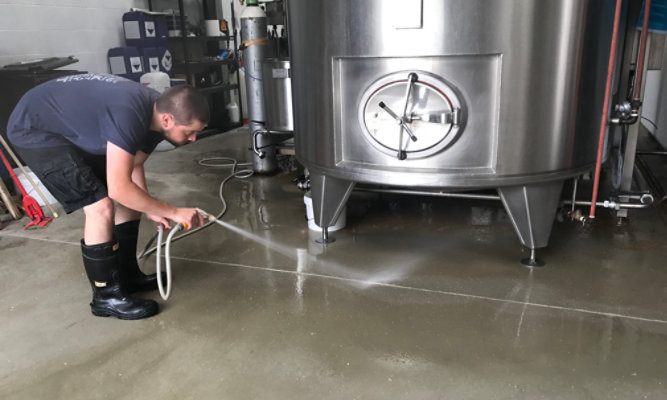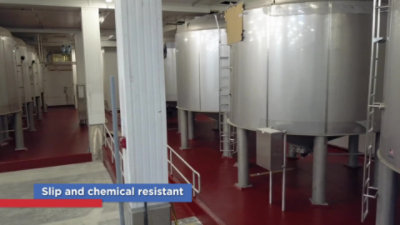Slippery Floor Solutions for Commercial & Industrial Facilities
Consider anti-slip epoxy or urethane flooring systems for slippery concrete flooring
Learn More or Get a Free Flooring Evaluation

When selecting a floor finish, one of the most important issues to be addressed is safety. Seamless floors composed of epoxy or urethane polymers are ideally suited for environments with high traffic loads (either foot or wheeled) due to the long-term wear and ease of cleaning. When selecting these systems in both decorative and industrial environments, slip resistance must be considered in determining the flooring system itself and the maintenance procedure.
What can cause slippery floors?
When flat and smooth surfaces like floors get wet or oily, they can become slippery. It only takes a little bit of moisture to turn a dry, safe floor into a slippery, dangerous floor. Slippery floors cause physical hazards and are one of the most significant issues in the workplace today.
Common slippery floor conditions & environments
There are many facilities and businesses that experience slippery floor hazards. Some of the facility types where anti-slip flooring is particularly beneficial include:
- Commercial kitchens
- Restaurants
- Hotels
- Grocery stores
- Retail stores
- Hospitals and clinics
- Food and beverage processing plants
- Parking decks
- Airports
- Manufacturing plants
- Labs
- Animal facilities
Slippery floor solutions & options
Highly aggressive surfaces as required in parking decks and other wet environments utilize aggregates incorporated into the flooring system to maximize the peak-to-trough differential. Aggregate selection in these systems will affect the long-term slip resistance. Sand is typically used as an inexpensive aggregate in textured floors, but aluminum oxide can be substituted to provide a much harder, longer lasting profile. Aluminum oxide is available is several different size ranges to yield a slight texture (220 mesh) to extremely aggressive (46 mesh) finish.
The binder resin itself plays an important role in maintaining long-term slip resistance. Polyurethane elastomers provide flexibility but cannot hold the aggregate as well as internally flexibilized epoxies. Urethane enamel topcoats are inherently less slippery than epoxy finishes. Utilizing silica, polypropylene or aluminum oxide aggregates in the topcoats can provide a relatively smooth (and cleanable) finish with a modest degree of slip-resistance.
When selecting a flooring system, consider performance first followed by appearance and design. Your floor system must withstand the chemicals of exposure, the abrasion anticipated, and any temperature variations. Within this selected group the appearance (color) and texture (finish coat) can then be specified.
Looking for slippery floor solutions? Sherwin-Williams has you covered.
At Sherwin-Williams, our mission is to provide you with the best possible slippery flooring solution to meet your facility’s needs. Our team of experts understands the importance of floor safety and its contribution to keeping your employees and visitors safe. Contact a Sherwin-Williams representative today to learn more about our anti-slip flooring systems.
DISCOVER MORE
Industry Expertise and Innovation
See how we help customers find customized solutions for their project and application challenges.
System Lookup
Find out more about our innovative floor systems for a variety of industries.
FIND A SYSTEM

